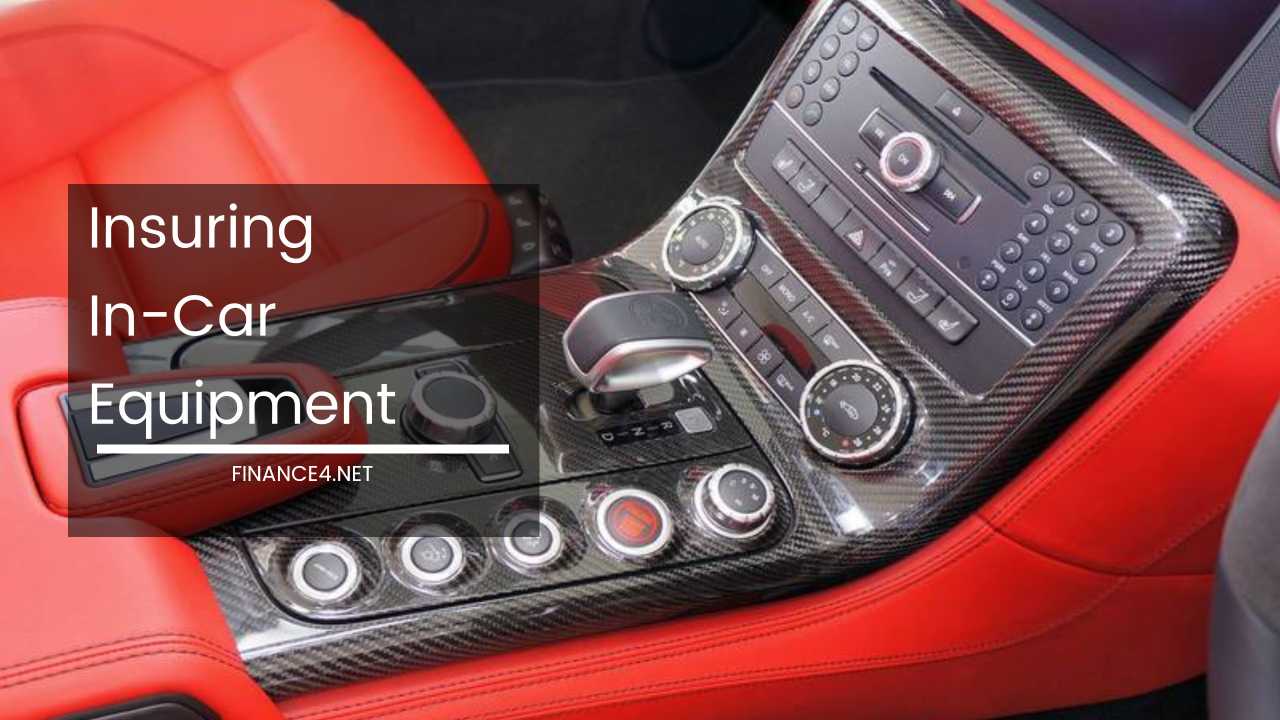Insuring In-Car Equipment: A Complete Guide

Insuring In-Car Equipment: A Comprehensive Guide to Keeping Your Gadgets Safe on the Road
The modern car is no longer just a means of transportation; it’s an extension of our connected lives. High-tech in-car equipment keeps us entertained, guides us to our destinations, and even enhances safety.
But with these advancements comes a new concern: protecting these valuable investments from theft or damage.
This comprehensive guide delves into the complexities of car insurance and in-car equipment, empowering you to make informed decisions for keeping your gadgets safe on the road.
Understanding What’s Covered: Standard Equipment vs. Aftermarket Upgrades
Car insurance policies generally cover permanently installed audio-visual equipment like stereos, entertainment systems, TVs, and even telephones. However, variations exist between insurers, so scrutinizing your policy documents is crucial.
Standard Features: If your car came equipped with these features directly from the factory, they’re likely covered under your standard policy. Most insurers include such equipment within the overall insured value of your car, eliminating the need for additional coverage.
Aftermarket Upgrades: Upgrading your car’s stereo system or installing a high-definition touchscreen navigation system introduces a new layer of complexity.
These changes can elevate your car’s risk profile for insurers, potentially leading to increased premiums. To avoid any surprises, it’s essential to notify your insurer about any modifications as soon as possible. This allows them to reassess your risk level and adjust your premium accordingly.
The Case of Sat-Navs: Satellite navigation systems (Sat-Navs) are another area where insurance coverage can differ significantly. Some insurers treat them similarly to stereos, while others might exclude them entirely from the base policy.
Additionally, some policies might only cover built-in navigation systems installed by the manufacturer, while aftermarket add-ons require separate coverage.
Beyond Standard Coverage: Protecting Your Investment
For those who have invested heavily in in-car equipment, a basic insurance policy might not be sufficient. Here’s where fully comprehensive car insurance comes into play.
Fully Comprehensive Coverage: Fully comprehensive (often abbreviated as “fully comp”) policies typically offer broader protection against theft and damage, including a range of in-car equipment up to a specified value.
This value can vary significantly between insurers, with some offering coverage exceeding £500, while others might only cover up to £100. Carefully reading the fine print is crucial to ensure your expensive gadgets are adequately protected.
Declared Value Coverage: Some insurers offer “declared value” coverage, which allows you to specify the value of your individual in-car equipment.
This ensures you receive the full replacement value in case of a claim, as opposed to the standard depreciation-based payout. However, declared value coverage typically comes with an additional premium cost.
Weighing the Cost of Coverage: A Numbers Game
The decision to insure your in-car equipment requires a careful cost-benefit analysis. Here’s a breakdown to help you make an informed decision:
High-Value Equipment: Consider the value of your new gadgets against the additional premium you’ll incur for comprehensive coverage.
If your brand new £800 stereo were stolen, the cost of comprehensive coverage that includes it would seem like a wise investment.
Low-Value Additions: For minor additions, a different approach might be more prudent. Let’s say you install a new Sat-Nav costing around £100.
You might find an insurance policy willing to cover it, but the excess (the amount you pay upfront in case of a claim) could be set at £100. In such a scenario, paying extra for insurance wouldn’t make much financial sense, as the actual payout from the claim would be minimal.
Beyond Price: Insurance isn’t just about financial compensation. Consider the inconvenience of replacing a stolen or damaged device. Insurance can streamline the process, providing assistance with filing claims and coordinating repairs or replacements.
Before You Buy: Considering Insurance Implications in Advance
Before splurging on that high-end speaker system or the latest navigation device with augmented reality features, take a moment to investigate how it might affect your insurance costs. Here are some proactive steps you can take:
Research: Check your current policy documents or contact your insurer for an estimate on how much your premium might increase with the new equipment. This pre-purchase research empowers you to make informed decisions based on your budget.
Negotiate: Some insurers might offer discounts for specific types of equipment, such as security systems or safety features like backup cameras. Exploring these options can help offset the cost of increased premiums.
Communication is Key: Keeping Your Insurer Informed
Transparency is vital when it comes to car insurance. As soon as you make any modifications to your car’s equipment, especially high-value additions, promptly inform your insurance company. This allows them to:
Update Policy Details and Discuss Coverage Options:
They’ll update your policy details to reflect the new equipment, ensuring you have proper coverage in case of theft or damage.
Discuss Coverage Options: Your insurer can advise you on the best coverage options for your specific equipment. They might suggest:
- Comprehensive Coverage: Including the new equipment under your existing comprehensive policy, potentially with an adjusted premium.
- Declared Value Coverage: Adding declared value coverage specifically for your high-value equipment, ensuring full replacement value in case of a claim.
- Standalone Add-On Coverage: Purchasing a separate add-on policy specifically for your in-car equipment, which might be a cost-effective option for some situations.
Maintaining Transparency: Developing a habit of informing your insurer about any modifications, even minor ones, helps maintain a transparent relationship. This prevents any coverage disputes in the future.
Understanding Your Policy: The Devil’s in the Details:
Don’t rely solely on the term “fully comprehensive” to guarantee complete coverage for your in-car equipment. Take the time to meticulously examine your policy documents, paying close attention to:
Covered Equipment: A clear list of the specific types of equipment covered under your policy.
- Value Limits: The maximum amount your insurer will pay for each piece of equipment or for the total value of covered equipment.
- Exclusions: Any specific types of equipment or situations that are not covered under your policy. This might include wear and tear, cosmetic damage, or certain types of modifications.
By understanding these details, you can identify any gaps in your coverage and make informed decisions about purchasing additional protection if necessary.
Considering Excess Costs: Don’t Get Caught Off Guard:
When evaluating insurance options, pay close attention to the excess amount for in-car equipment claims. Remember, the excess is the portion you’ll have to pay upfront before your insurance kicks in. Here are some additional considerations:
Varying Excess Levels: Excess amounts can vary depending on your policy type, the type of claim, and even the value of the damaged equipment.
- Matching Excess to Value: For lower-value equipment, the excess might be close to the value of the item. In such scenarios, insurance might not be financially worthwhile.
- Negotiating Excess: In some cases, you might be able to negotiate a lower excess with your insurer, especially if you have a good claims history.
By understanding the excess structure, you can avoid any financial surprises in the event of a claim.
Beyond Theft and Damage: Additional Considerations
While theft and damage are the primary concerns, some insurance policies might offer additional benefits for in-car equipment:
Loss Coverage: Coverage in case you lose your detachable Sat-Nav or phone within your car. Vandalism Coverage: Protection against damage caused by vandalism or malicious acts. Personal Belongings Coverage: Coverage for other personal belongings stored in your car, depending on the policy limitations.
Understanding these additional coverages can provide a more comprehensive safety net for your in-car valuables.
Final Thoughts: Making Informed Decisions for a Secure Ride
By following these guidelines, you can make informed decisions about insuring your in-car equipment. Remember, the key lies in understanding your specific needs, the value of your equipment, and the details of your insurance policy.
By striking a balance between cost and coverage, you can ensure your gadgets are protected while keeping your car insurance premiums manageable. This allows you to enjoy the enhanced driving experience offered by modern technology with peace of mind.



